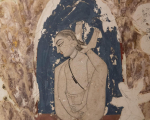The Nath sampraday is a religious order that is today spread throughout India and Nepal. It comprises an ascetic branch as well as a householder caste, both of whom trace their lineage to nine primary gurus or the Navnaths. Shiva, who is also known as Adinath (literally the first and original Nath) is placed at the helm of the sampraday and is treated as a primary deity.
More loosely referred to as yogis or jogis (a vernacular variation of the former), Nath ascetics are traditionally associated with the practice of Hatha Yoga and Tantra. They are also sometimes known as Kanphatas (literally, ‘split eared’) on account of the large earrings that they wear, though it is a term that they themselves eschew.
The ascetic order of the Nath sampraday is believed to have been founded by Gorakhnath (or Gorakshnath), an influential 11th-century figure, who appears in several legends and mythical stories and is acknowledged as the first proponent of Hatha Yoga. A large corpus of vernacular poetry that is often referred to together as the Gorakhbani is attributed to him even though scholars believe that it was composed only a few centuries later, having taken in influences from the Sant tradition of North India (the lineage of Kabir, Nanak, Dadu etc.).
A feature that is today associated with both the Sant and the Nath traditions is nirgun bhakti or the practice of devotion towards a formless God that rejects elaborate religious ceremonies and sect- or caste-based differences. Another, is the elevated position of the guru, who, in the absence of a manifest deity, seems to gain added importance in both traditions.
In the context of the Nath sampraday specifically, it is fascinating to explore the various spiritual practices associated with the community. The ways in which they organize themselves, their myths and legends, the sites and spaces that they inhabit and the physical markers of the individual yogi all speak of a tradition that is both longstanding and dynamic, that is simultaneously trying to guard its core and constantly interacting with and adapting to its environment.
In Rajasthan, the Sahapedia team visited mathas (religious institutions), temples and other centres of importance for the Naths in Pushkar, Jodhpur, Pokhran, Kanoi and Myajlar, interviewing mahants, devotees and lay practitioners from both the ascetic and the householder branch of the samprday and recording bhajans, kathas (legendary tales) and other kinds of oral history from traditional performers of the Kalbeliya, Manganiyar and the Meghwal communities.
In Himachal Pradesh, we visited the Jwalamukhi Shaktipeeth (a shrine dedicated to Shakti) documenting the temple on the first day of the Navaratri festivities and exploring its relationship with the Nath sampradaya, which has a dedicated space within the temple premises and traces its association with the site to a legendary meeting between Gorakhnath and Jwala Devi (the primary manifestation of Shakti worshipped at the temple).
Bharucha, Rustom. An Oral History of Rajasthan: Conversations with Komal Kothari. New Delhi: Penguin, 2003.
Bouillier, Véronique. ‘Kānphaṭās’, Volume 3 of Brill’s Encyclopedia of Hinduism, edited by Knut A. Jacobsen, Helene Basu, Angelika Malinar and Vasudha Narayanan, 347–54. Leiden: Brill, 2011.
Mallinson, James. 'Nāth Saṃpradāya', Volume 3 of Brill’s Encyclopedia of Hinduism, edited by Knut A. Jacobsen, Helene Basu, Angelika Malinar and Vasudha Narayanan, 407–28. Leiden: Brill, 2011.
Sharma, Mahesh. 2006, 'Shaktism in Himachal' in Religious Movements and Institutions in Medieval India. Volume 7, Part 2 of History of Science, Philosophy and Culture in Indian Civilization, edited by J.S. Grewal, 95–109. New Delhi: Oxford University Press, 2006.
Sahapedia is grateful to Bajaj Autos Pvt. Ltd. for the grant that made possible the documentation for this photo essay.

















